Organizational Behaviour: Culture, Motivation & Teamwork at Workplace
VerifiedAdded on 2023/06/09
|15
|5329
|133
Report
AI Summary
This report examines organizational behaviour, emphasizing the significance of organizational culture and motivation on employee behaviour and performance, particularly within KPMG. It discusses various organizational culture and motivational theories, identifying the clan culture and Maslow's theory as relevant to KPMG. The report provides an overview of KPMG's culture, politics, and power dynamics, along with examples. Furthermore, it explores teamwork, its benefits, and effectiveness in achieving goals, referencing group development theories. Two models of organizational behaviour are presented, followed by a reflection on effective teamwork's influence on workplace behaviour. The report concludes with recommendations for KPMG to enhance employee engagement and organizational performance by considering Herzberg's motivational theory and focusing on employee engagement and company environment.
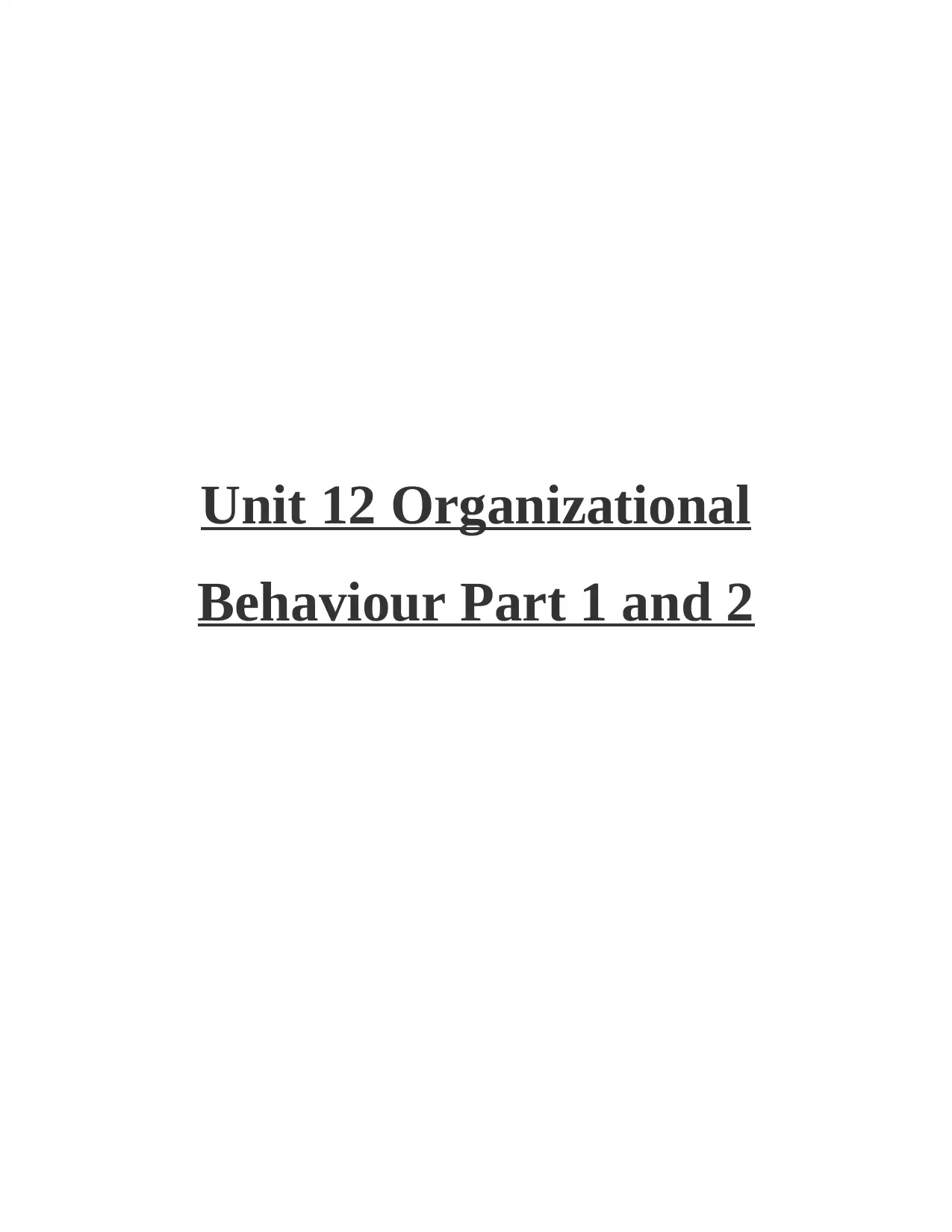
Unit 12 Organizational
Behaviour Part 1 and 2
Behaviour Part 1 and 2
Paraphrase This Document
Need a fresh take? Get an instant paraphrase of this document with our AI Paraphraser
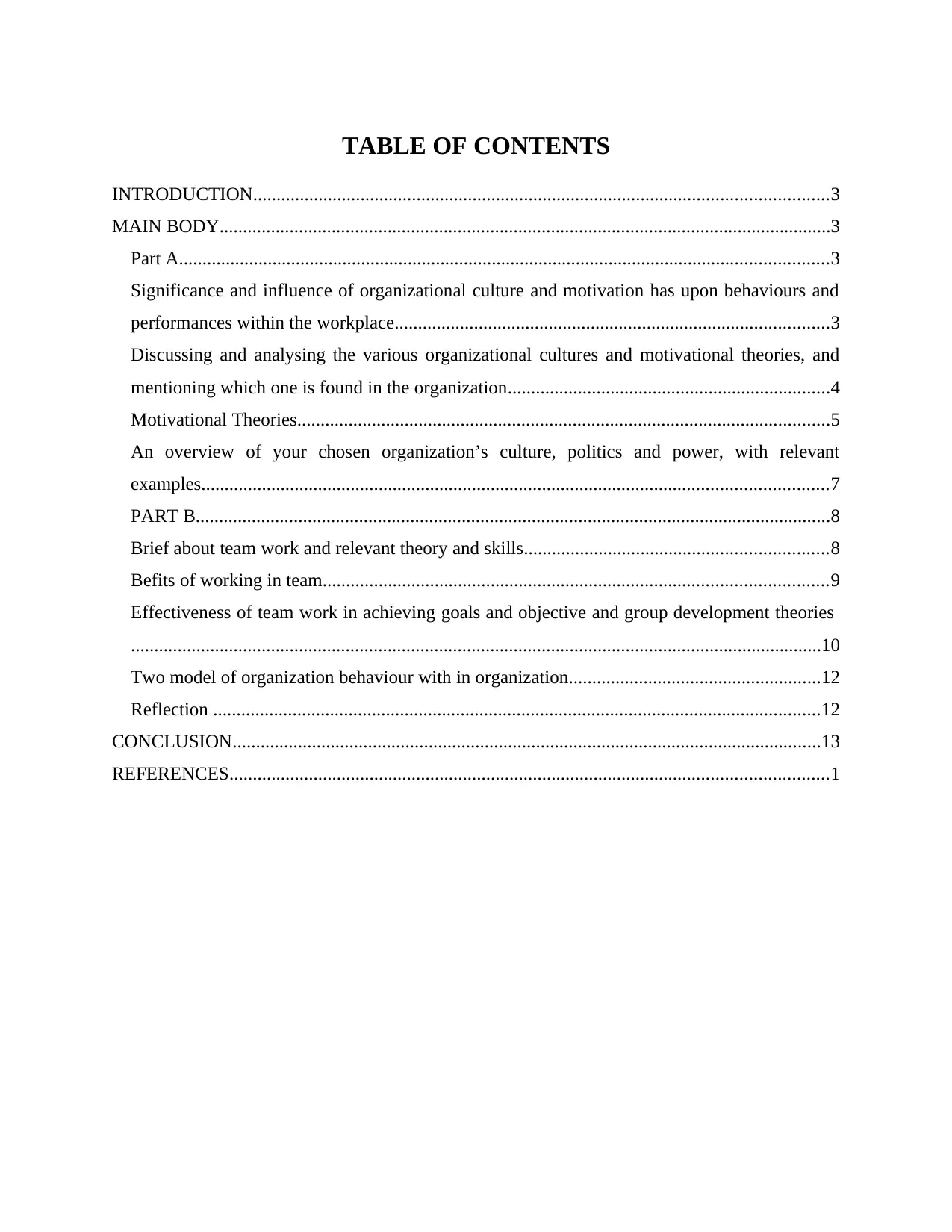
TABLE OF CONTENTS
INTRODUCTION...........................................................................................................................3
MAIN BODY...................................................................................................................................3
Part A...........................................................................................................................................3
Significance and influence of organizational culture and motivation has upon behaviours and
performances within the workplace.............................................................................................3
Discussing and analysing the various organizational cultures and motivational theories, and
mentioning which one is found in the organization.....................................................................4
Motivational Theories..................................................................................................................5
An overview of your chosen organization’s culture, politics and power, with relevant
examples......................................................................................................................................7
PART B........................................................................................................................................8
Brief about team work and relevant theory and skills.................................................................8
Befits of working in team............................................................................................................9
Effectiveness of team work in achieving goals and objective and group development theories
....................................................................................................................................................10
Two model of organization behaviour with in organization......................................................12
Reflection ..................................................................................................................................12
CONCLUSION..............................................................................................................................13
REFERENCES................................................................................................................................1
INTRODUCTION...........................................................................................................................3
MAIN BODY...................................................................................................................................3
Part A...........................................................................................................................................3
Significance and influence of organizational culture and motivation has upon behaviours and
performances within the workplace.............................................................................................3
Discussing and analysing the various organizational cultures and motivational theories, and
mentioning which one is found in the organization.....................................................................4
Motivational Theories..................................................................................................................5
An overview of your chosen organization’s culture, politics and power, with relevant
examples......................................................................................................................................7
PART B........................................................................................................................................8
Brief about team work and relevant theory and skills.................................................................8
Befits of working in team............................................................................................................9
Effectiveness of team work in achieving goals and objective and group development theories
....................................................................................................................................................10
Two model of organization behaviour with in organization......................................................12
Reflection ..................................................................................................................................12
CONCLUSION..............................................................................................................................13
REFERENCES................................................................................................................................1
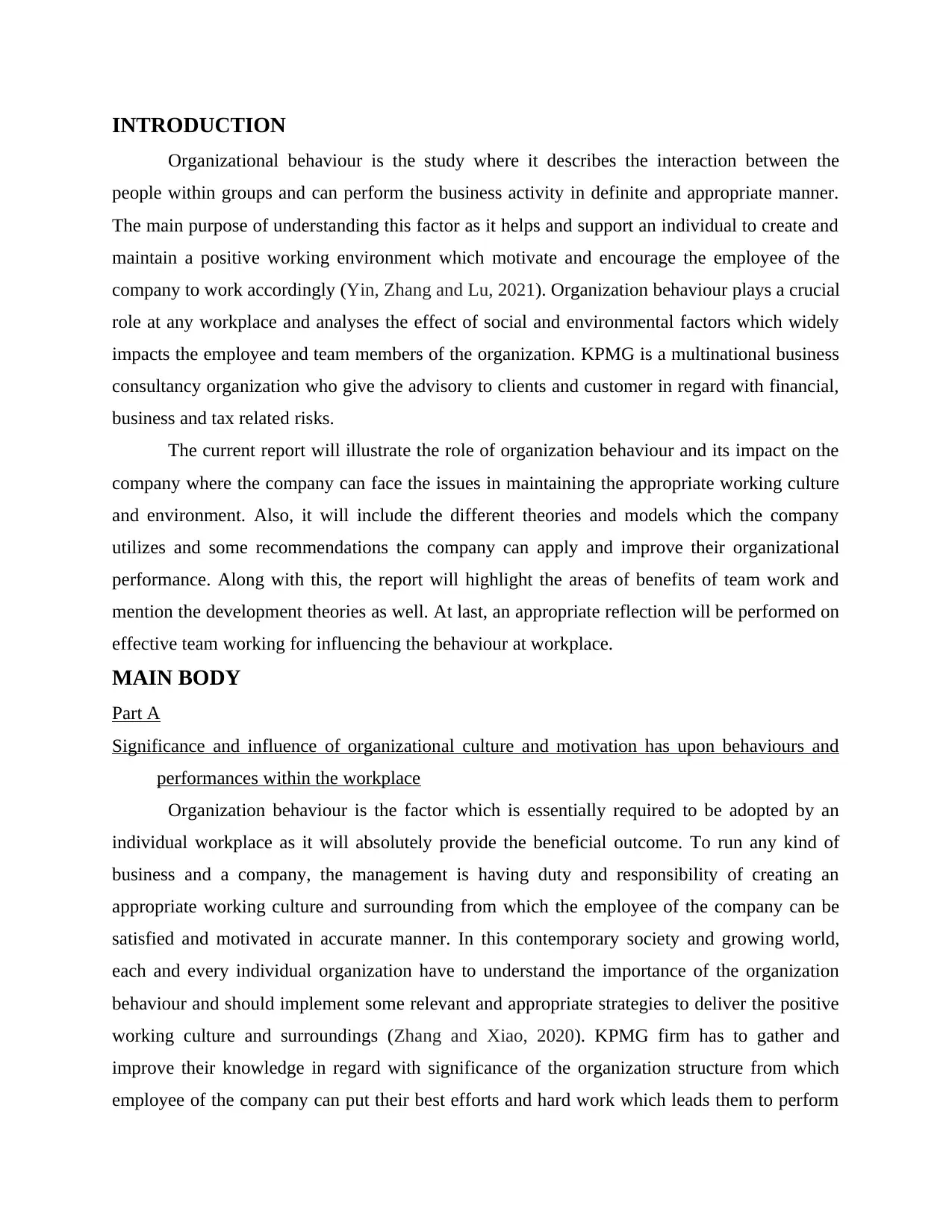
INTRODUCTION
Organizational behaviour is the study where it describes the interaction between the
people within groups and can perform the business activity in definite and appropriate manner.
The main purpose of understanding this factor as it helps and support an individual to create and
maintain a positive working environment which motivate and encourage the employee of the
company to work accordingly (Yin, Zhang and Lu, 2021). Organization behaviour plays a crucial
role at any workplace and analyses the effect of social and environmental factors which widely
impacts the employee and team members of the organization. KPMG is a multinational business
consultancy organization who give the advisory to clients and customer in regard with financial,
business and tax related risks.
The current report will illustrate the role of organization behaviour and its impact on the
company where the company can face the issues in maintaining the appropriate working culture
and environment. Also, it will include the different theories and models which the company
utilizes and some recommendations the company can apply and improve their organizational
performance. Along with this, the report will highlight the areas of benefits of team work and
mention the development theories as well. At last, an appropriate reflection will be performed on
effective team working for influencing the behaviour at workplace.
MAIN BODY
Part A
Significance and influence of organizational culture and motivation has upon behaviours and
performances within the workplace
Organization behaviour is the factor which is essentially required to be adopted by an
individual workplace as it will absolutely provide the beneficial outcome. To run any kind of
business and a company, the management is having duty and responsibility of creating an
appropriate working culture and surrounding from which the employee of the company can be
satisfied and motivated in accurate manner. In this contemporary society and growing world,
each and every individual organization have to understand the importance of the organization
behaviour and should implement some relevant and appropriate strategies to deliver the positive
working culture and surroundings (Zhang and Xiao, 2020). KPMG firm has to gather and
improve their knowledge in regard with significance of the organization structure from which
employee of the company can put their best efforts and hard work which leads them to perform
Organizational behaviour is the study where it describes the interaction between the
people within groups and can perform the business activity in definite and appropriate manner.
The main purpose of understanding this factor as it helps and support an individual to create and
maintain a positive working environment which motivate and encourage the employee of the
company to work accordingly (Yin, Zhang and Lu, 2021). Organization behaviour plays a crucial
role at any workplace and analyses the effect of social and environmental factors which widely
impacts the employee and team members of the organization. KPMG is a multinational business
consultancy organization who give the advisory to clients and customer in regard with financial,
business and tax related risks.
The current report will illustrate the role of organization behaviour and its impact on the
company where the company can face the issues in maintaining the appropriate working culture
and environment. Also, it will include the different theories and models which the company
utilizes and some recommendations the company can apply and improve their organizational
performance. Along with this, the report will highlight the areas of benefits of team work and
mention the development theories as well. At last, an appropriate reflection will be performed on
effective team working for influencing the behaviour at workplace.
MAIN BODY
Part A
Significance and influence of organizational culture and motivation has upon behaviours and
performances within the workplace
Organization behaviour is the factor which is essentially required to be adopted by an
individual workplace as it will absolutely provide the beneficial outcome. To run any kind of
business and a company, the management is having duty and responsibility of creating an
appropriate working culture and surrounding from which the employee of the company can be
satisfied and motivated in accurate manner. In this contemporary society and growing world,
each and every individual organization have to understand the importance of the organization
behaviour and should implement some relevant and appropriate strategies to deliver the positive
working culture and surroundings (Zhang and Xiao, 2020). KPMG firm has to gather and
improve their knowledge in regard with significance of the organization structure from which
employee of the company can put their best efforts and hard work which leads them to perform
⊘ This is a preview!⊘
Do you want full access?
Subscribe today to unlock all pages.

Trusted by 1+ million students worldwide
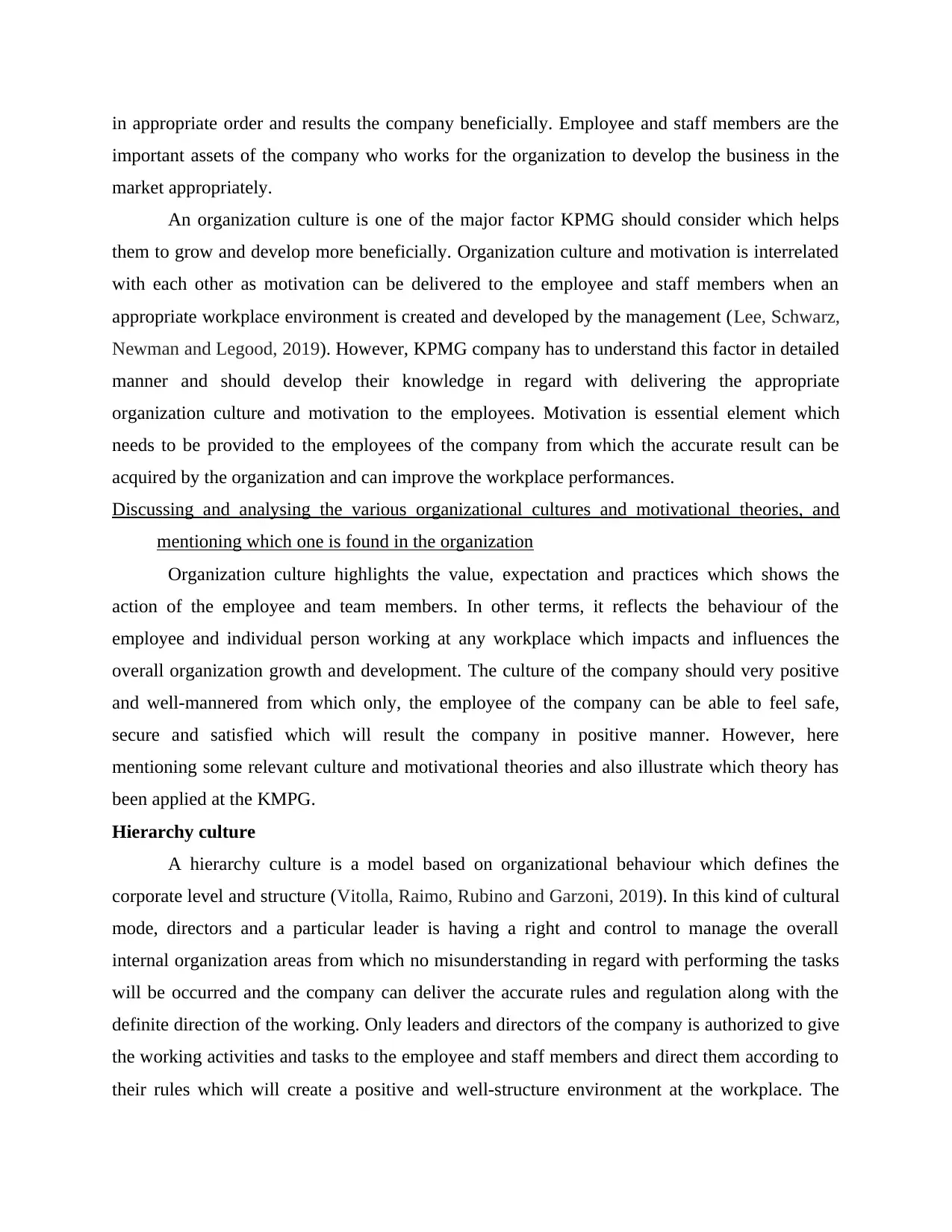
in appropriate order and results the company beneficially. Employee and staff members are the
important assets of the company who works for the organization to develop the business in the
market appropriately.
An organization culture is one of the major factor KPMG should consider which helps
them to grow and develop more beneficially. Organization culture and motivation is interrelated
with each other as motivation can be delivered to the employee and staff members when an
appropriate workplace environment is created and developed by the management (Lee, Schwarz,
Newman and Legood, 2019). However, KPMG company has to understand this factor in detailed
manner and should develop their knowledge in regard with delivering the appropriate
organization culture and motivation to the employees. Motivation is essential element which
needs to be provided to the employees of the company from which the accurate result can be
acquired by the organization and can improve the workplace performances.
Discussing and analysing the various organizational cultures and motivational theories, and
mentioning which one is found in the organization
Organization culture highlights the value, expectation and practices which shows the
action of the employee and team members. In other terms, it reflects the behaviour of the
employee and individual person working at any workplace which impacts and influences the
overall organization growth and development. The culture of the company should very positive
and well-mannered from which only, the employee of the company can be able to feel safe,
secure and satisfied which will result the company in positive manner. However, here
mentioning some relevant culture and motivational theories and also illustrate which theory has
been applied at the KMPG.
Hierarchy culture
A hierarchy culture is a model based on organizational behaviour which defines the
corporate level and structure (Vitolla, Raimo, Rubino and Garzoni, 2019). In this kind of cultural
mode, directors and a particular leader is having a right and control to manage the overall
internal organization areas from which no misunderstanding in regard with performing the tasks
will be occurred and the company can deliver the accurate rules and regulation along with the
definite direction of the working. Only leaders and directors of the company is authorized to give
the working activities and tasks to the employee and staff members and direct them according to
their rules which will create a positive and well-structure environment at the workplace. The
important assets of the company who works for the organization to develop the business in the
market appropriately.
An organization culture is one of the major factor KPMG should consider which helps
them to grow and develop more beneficially. Organization culture and motivation is interrelated
with each other as motivation can be delivered to the employee and staff members when an
appropriate workplace environment is created and developed by the management (Lee, Schwarz,
Newman and Legood, 2019). However, KPMG company has to understand this factor in detailed
manner and should develop their knowledge in regard with delivering the appropriate
organization culture and motivation to the employees. Motivation is essential element which
needs to be provided to the employees of the company from which the accurate result can be
acquired by the organization and can improve the workplace performances.
Discussing and analysing the various organizational cultures and motivational theories, and
mentioning which one is found in the organization
Organization culture highlights the value, expectation and practices which shows the
action of the employee and team members. In other terms, it reflects the behaviour of the
employee and individual person working at any workplace which impacts and influences the
overall organization growth and development. The culture of the company should very positive
and well-mannered from which only, the employee of the company can be able to feel safe,
secure and satisfied which will result the company in positive manner. However, here
mentioning some relevant culture and motivational theories and also illustrate which theory has
been applied at the KMPG.
Hierarchy culture
A hierarchy culture is a model based on organizational behaviour which defines the
corporate level and structure (Vitolla, Raimo, Rubino and Garzoni, 2019). In this kind of cultural
mode, directors and a particular leader is having a right and control to manage the overall
internal organization areas from which no misunderstanding in regard with performing the tasks
will be occurred and the company can deliver the accurate rules and regulation along with the
definite direction of the working. Only leaders and directors of the company is authorized to give
the working activities and tasks to the employee and staff members and direct them according to
their rules which will create a positive and well-structure environment at the workplace. The
Paraphrase This Document
Need a fresh take? Get an instant paraphrase of this document with our AI Paraphraser
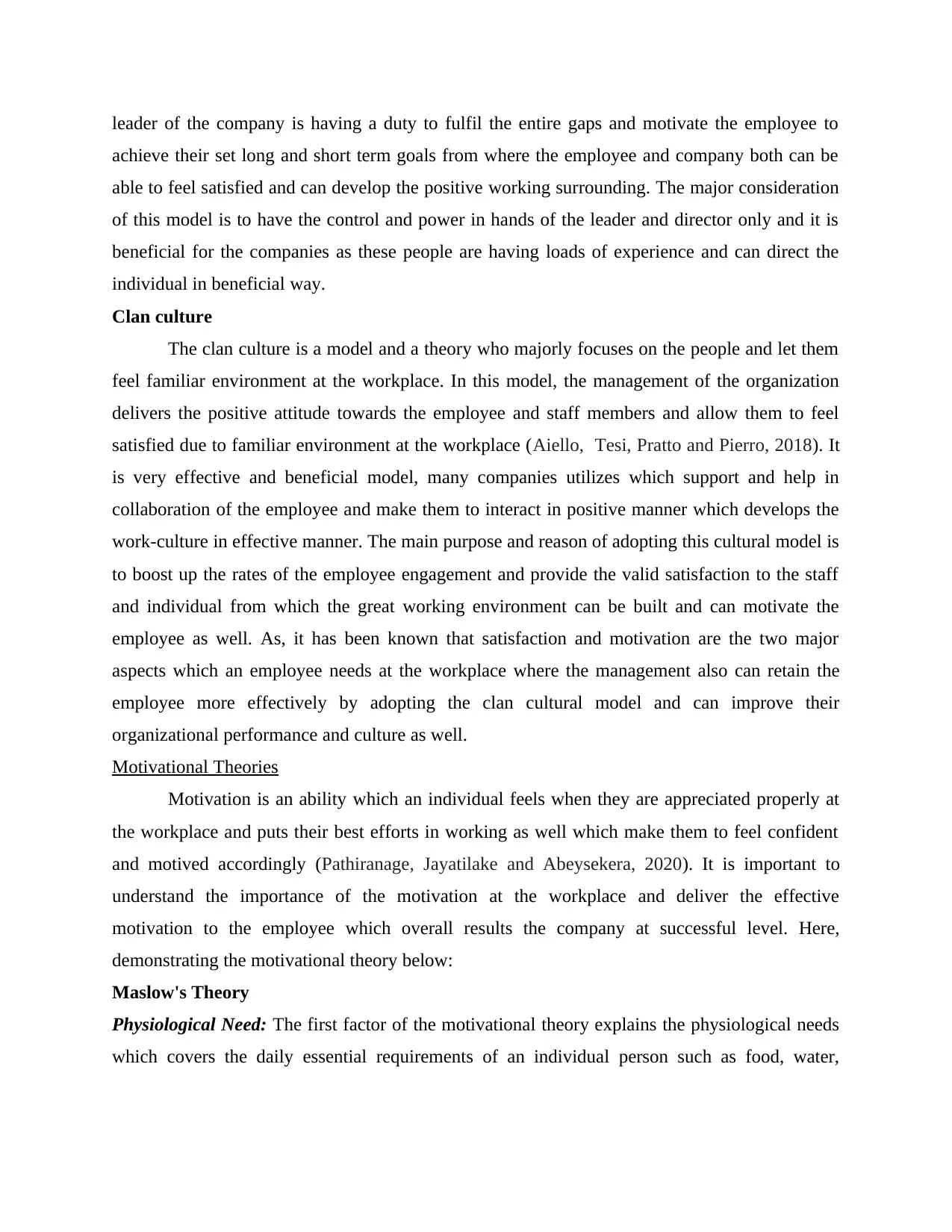
leader of the company is having a duty to fulfil the entire gaps and motivate the employee to
achieve their set long and short term goals from where the employee and company both can be
able to feel satisfied and can develop the positive working surrounding. The major consideration
of this model is to have the control and power in hands of the leader and director only and it is
beneficial for the companies as these people are having loads of experience and can direct the
individual in beneficial way.
Clan culture
The clan culture is a model and a theory who majorly focuses on the people and let them
feel familiar environment at the workplace. In this model, the management of the organization
delivers the positive attitude towards the employee and staff members and allow them to feel
satisfied due to familiar environment at the workplace (Aiello, Tesi, Pratto and Pierro, 2018). It
is very effective and beneficial model, many companies utilizes which support and help in
collaboration of the employee and make them to interact in positive manner which develops the
work-culture in effective manner. The main purpose and reason of adopting this cultural model is
to boost up the rates of the employee engagement and provide the valid satisfaction to the staff
and individual from which the great working environment can be built and can motivate the
employee as well. As, it has been known that satisfaction and motivation are the two major
aspects which an employee needs at the workplace where the management also can retain the
employee more effectively by adopting the clan cultural model and can improve their
organizational performance and culture as well.
Motivational Theories
Motivation is an ability which an individual feels when they are appreciated properly at
the workplace and puts their best efforts in working as well which make them to feel confident
and motived accordingly (Pathiranage, Jayatilake and Abeysekera, 2020). It is important to
understand the importance of the motivation at the workplace and deliver the effective
motivation to the employee which overall results the company at successful level. Here,
demonstrating the motivational theory below:
Maslow's Theory
Physiological Need: The first factor of the motivational theory explains the physiological needs
which covers the daily essential requirements of an individual person such as food, water,
achieve their set long and short term goals from where the employee and company both can be
able to feel satisfied and can develop the positive working surrounding. The major consideration
of this model is to have the control and power in hands of the leader and director only and it is
beneficial for the companies as these people are having loads of experience and can direct the
individual in beneficial way.
Clan culture
The clan culture is a model and a theory who majorly focuses on the people and let them
feel familiar environment at the workplace. In this model, the management of the organization
delivers the positive attitude towards the employee and staff members and allow them to feel
satisfied due to familiar environment at the workplace (Aiello, Tesi, Pratto and Pierro, 2018). It
is very effective and beneficial model, many companies utilizes which support and help in
collaboration of the employee and make them to interact in positive manner which develops the
work-culture in effective manner. The main purpose and reason of adopting this cultural model is
to boost up the rates of the employee engagement and provide the valid satisfaction to the staff
and individual from which the great working environment can be built and can motivate the
employee as well. As, it has been known that satisfaction and motivation are the two major
aspects which an employee needs at the workplace where the management also can retain the
employee more effectively by adopting the clan cultural model and can improve their
organizational performance and culture as well.
Motivational Theories
Motivation is an ability which an individual feels when they are appreciated properly at
the workplace and puts their best efforts in working as well which make them to feel confident
and motived accordingly (Pathiranage, Jayatilake and Abeysekera, 2020). It is important to
understand the importance of the motivation at the workplace and deliver the effective
motivation to the employee which overall results the company at successful level. Here,
demonstrating the motivational theory below:
Maslow's Theory
Physiological Need: The first factor of the motivational theory explains the physiological needs
which covers the daily essential requirements of an individual person such as food, water,
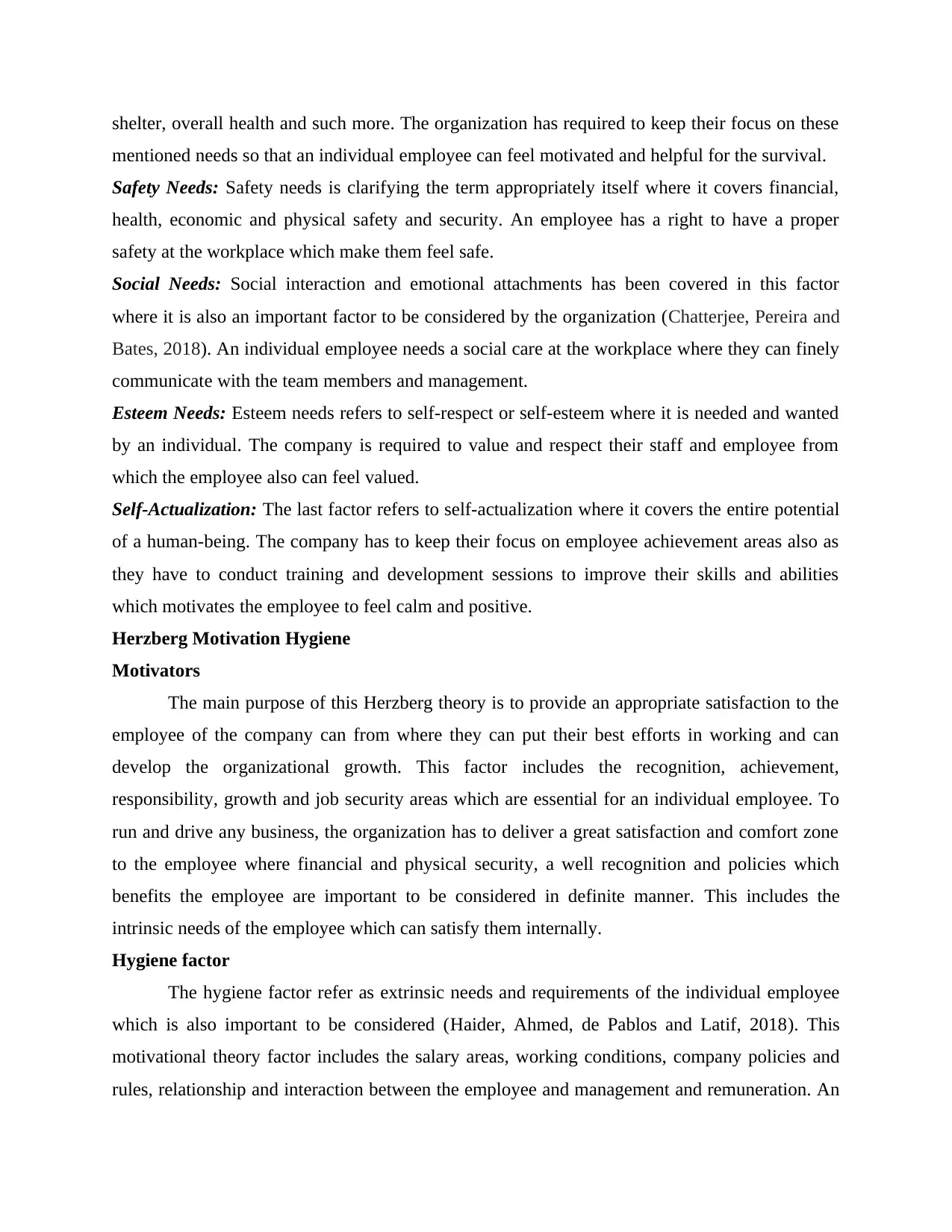
shelter, overall health and such more. The organization has required to keep their focus on these
mentioned needs so that an individual employee can feel motivated and helpful for the survival.
Safety Needs: Safety needs is clarifying the term appropriately itself where it covers financial,
health, economic and physical safety and security. An employee has a right to have a proper
safety at the workplace which make them feel safe.
Social Needs: Social interaction and emotional attachments has been covered in this factor
where it is also an important factor to be considered by the organization (Chatterjee, Pereira and
Bates, 2018). An individual employee needs a social care at the workplace where they can finely
communicate with the team members and management.
Esteem Needs: Esteem needs refers to self-respect or self-esteem where it is needed and wanted
by an individual. The company is required to value and respect their staff and employee from
which the employee also can feel valued.
Self-Actualization: The last factor refers to self-actualization where it covers the entire potential
of a human-being. The company has to keep their focus on employee achievement areas also as
they have to conduct training and development sessions to improve their skills and abilities
which motivates the employee to feel calm and positive.
Herzberg Motivation Hygiene
Motivators
The main purpose of this Herzberg theory is to provide an appropriate satisfaction to the
employee of the company can from where they can put their best efforts in working and can
develop the organizational growth. This factor includes the recognition, achievement,
responsibility, growth and job security areas which are essential for an individual employee. To
run and drive any business, the organization has to deliver a great satisfaction and comfort zone
to the employee where financial and physical security, a well recognition and policies which
benefits the employee are important to be considered in definite manner. This includes the
intrinsic needs of the employee which can satisfy them internally.
Hygiene factor
The hygiene factor refer as extrinsic needs and requirements of the individual employee
which is also important to be considered (Haider, Ahmed, de Pablos and Latif, 2018). This
motivational theory factor includes the salary areas, working conditions, company policies and
rules, relationship and interaction between the employee and management and remuneration. An
mentioned needs so that an individual employee can feel motivated and helpful for the survival.
Safety Needs: Safety needs is clarifying the term appropriately itself where it covers financial,
health, economic and physical safety and security. An employee has a right to have a proper
safety at the workplace which make them feel safe.
Social Needs: Social interaction and emotional attachments has been covered in this factor
where it is also an important factor to be considered by the organization (Chatterjee, Pereira and
Bates, 2018). An individual employee needs a social care at the workplace where they can finely
communicate with the team members and management.
Esteem Needs: Esteem needs refers to self-respect or self-esteem where it is needed and wanted
by an individual. The company is required to value and respect their staff and employee from
which the employee also can feel valued.
Self-Actualization: The last factor refers to self-actualization where it covers the entire potential
of a human-being. The company has to keep their focus on employee achievement areas also as
they have to conduct training and development sessions to improve their skills and abilities
which motivates the employee to feel calm and positive.
Herzberg Motivation Hygiene
Motivators
The main purpose of this Herzberg theory is to provide an appropriate satisfaction to the
employee of the company can from where they can put their best efforts in working and can
develop the organizational growth. This factor includes the recognition, achievement,
responsibility, growth and job security areas which are essential for an individual employee. To
run and drive any business, the organization has to deliver a great satisfaction and comfort zone
to the employee where financial and physical security, a well recognition and policies which
benefits the employee are important to be considered in definite manner. This includes the
intrinsic needs of the employee which can satisfy them internally.
Hygiene factor
The hygiene factor refer as extrinsic needs and requirements of the individual employee
which is also important to be considered (Haider, Ahmed, de Pablos and Latif, 2018). This
motivational theory factor includes the salary areas, working conditions, company policies and
rules, relationship and interaction between the employee and management and remuneration. An
⊘ This is a preview!⊘
Do you want full access?
Subscribe today to unlock all pages.

Trusted by 1+ million students worldwide
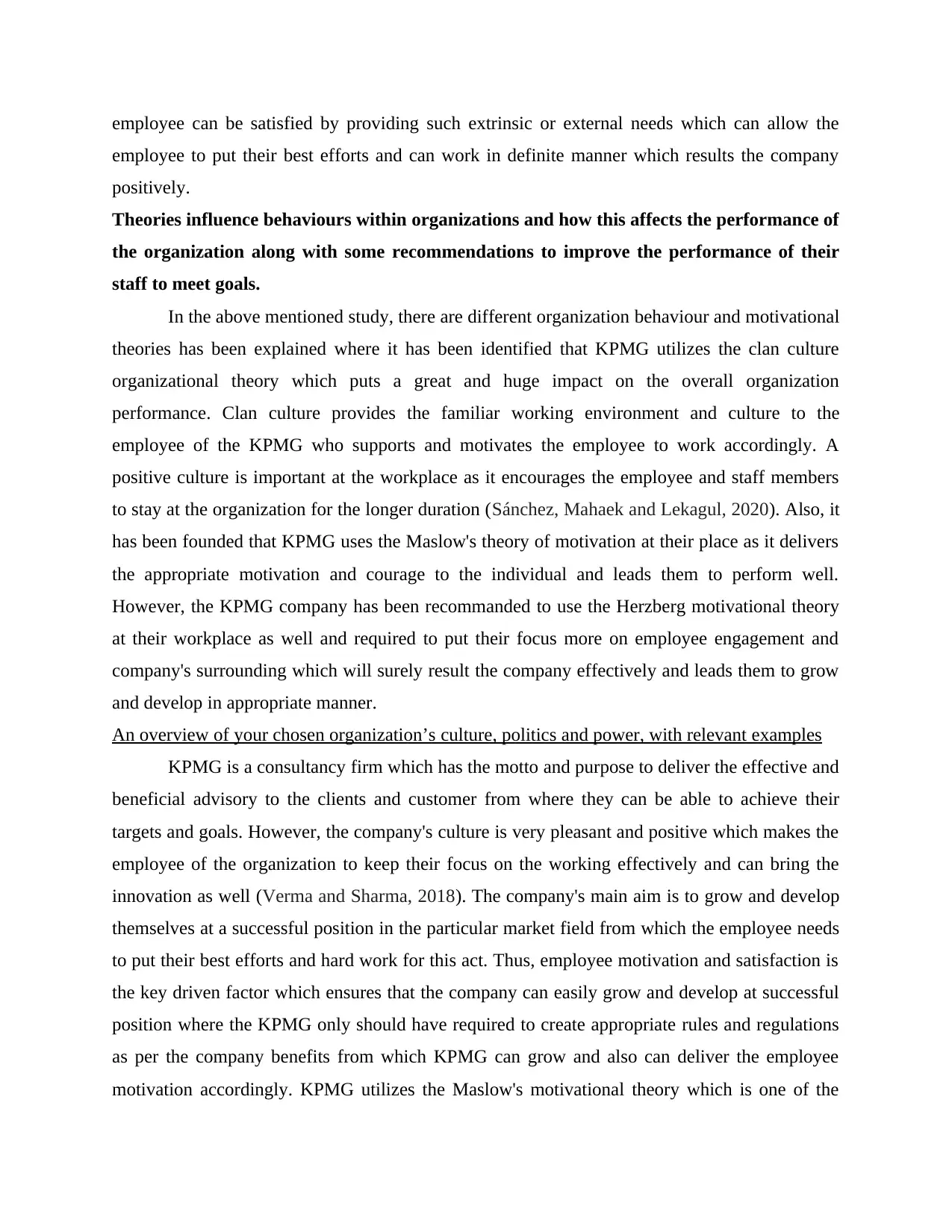
employee can be satisfied by providing such extrinsic or external needs which can allow the
employee to put their best efforts and can work in definite manner which results the company
positively.
Theories influence behaviours within organizations and how this affects the performance of
the organization along with some recommendations to improve the performance of their
staff to meet goals.
In the above mentioned study, there are different organization behaviour and motivational
theories has been explained where it has been identified that KPMG utilizes the clan culture
organizational theory which puts a great and huge impact on the overall organization
performance. Clan culture provides the familiar working environment and culture to the
employee of the KPMG who supports and motivates the employee to work accordingly. A
positive culture is important at the workplace as it encourages the employee and staff members
to stay at the organization for the longer duration (Sánchez, Mahaek and Lekagul, 2020). Also, it
has been founded that KPMG uses the Maslow's theory of motivation at their place as it delivers
the appropriate motivation and courage to the individual and leads them to perform well.
However, the KPMG company has been recommanded to use the Herzberg motivational theory
at their workplace as well and required to put their focus more on employee engagement and
company's surrounding which will surely result the company effectively and leads them to grow
and develop in appropriate manner.
An overview of your chosen organization’s culture, politics and power, with relevant examples
KPMG is a consultancy firm which has the motto and purpose to deliver the effective and
beneficial advisory to the clients and customer from where they can be able to achieve their
targets and goals. However, the company's culture is very pleasant and positive which makes the
employee of the organization to keep their focus on the working effectively and can bring the
innovation as well (Verma and Sharma, 2018). The company's main aim is to grow and develop
themselves at a successful position in the particular market field from which the employee needs
to put their best efforts and hard work for this act. Thus, employee motivation and satisfaction is
the key driven factor which ensures that the company can easily grow and develop at successful
position where the KPMG only should have required to create appropriate rules and regulations
as per the company benefits from which KPMG can grow and also can deliver the employee
motivation accordingly. KPMG utilizes the Maslow's motivational theory which is one of the
employee to put their best efforts and can work in definite manner which results the company
positively.
Theories influence behaviours within organizations and how this affects the performance of
the organization along with some recommendations to improve the performance of their
staff to meet goals.
In the above mentioned study, there are different organization behaviour and motivational
theories has been explained where it has been identified that KPMG utilizes the clan culture
organizational theory which puts a great and huge impact on the overall organization
performance. Clan culture provides the familiar working environment and culture to the
employee of the KPMG who supports and motivates the employee to work accordingly. A
positive culture is important at the workplace as it encourages the employee and staff members
to stay at the organization for the longer duration (Sánchez, Mahaek and Lekagul, 2020). Also, it
has been founded that KPMG uses the Maslow's theory of motivation at their place as it delivers
the appropriate motivation and courage to the individual and leads them to perform well.
However, the KPMG company has been recommanded to use the Herzberg motivational theory
at their workplace as well and required to put their focus more on employee engagement and
company's surrounding which will surely result the company effectively and leads them to grow
and develop in appropriate manner.
An overview of your chosen organization’s culture, politics and power, with relevant examples
KPMG is a consultancy firm which has the motto and purpose to deliver the effective and
beneficial advisory to the clients and customer from where they can be able to achieve their
targets and goals. However, the company's culture is very pleasant and positive which makes the
employee of the organization to keep their focus on the working effectively and can bring the
innovation as well (Verma and Sharma, 2018). The company's main aim is to grow and develop
themselves at a successful position in the particular market field from which the employee needs
to put their best efforts and hard work for this act. Thus, employee motivation and satisfaction is
the key driven factor which ensures that the company can easily grow and develop at successful
position where the KPMG only should have required to create appropriate rules and regulations
as per the company benefits from which KPMG can grow and also can deliver the employee
motivation accordingly. KPMG utilizes the Maslow's motivational theory which is one of the
Paraphrase This Document
Need a fresh take? Get an instant paraphrase of this document with our AI Paraphraser
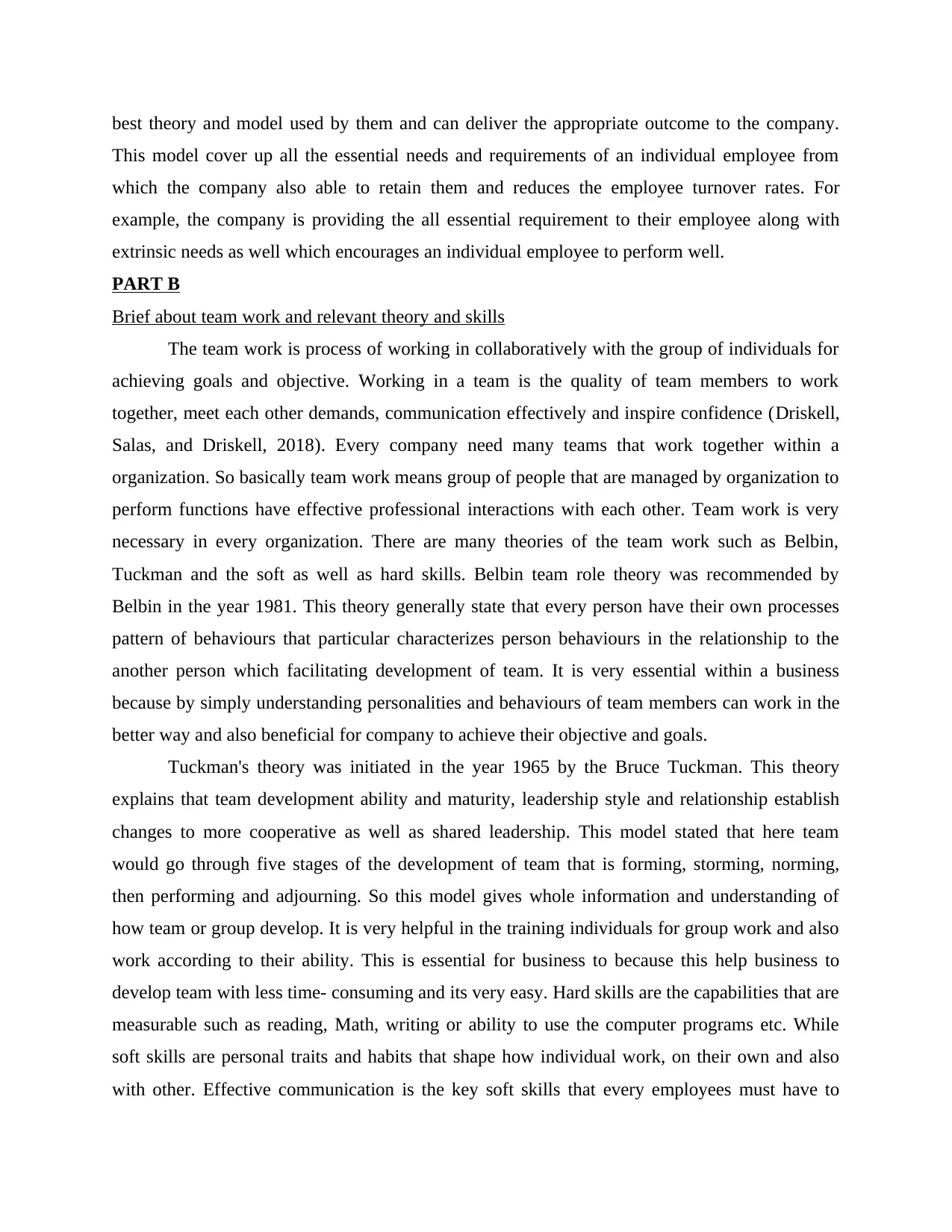
best theory and model used by them and can deliver the appropriate outcome to the company.
This model cover up all the essential needs and requirements of an individual employee from
which the company also able to retain them and reduces the employee turnover rates. For
example, the company is providing the all essential requirement to their employee along with
extrinsic needs as well which encourages an individual employee to perform well.
PART B
Brief about team work and relevant theory and skills
The team work is process of working in collaboratively with the group of individuals for
achieving goals and objective. Working in a team is the quality of team members to work
together, meet each other demands, communication effectively and inspire confidence (Driskell,
Salas, and Driskell, 2018). Every company need many teams that work together within a
organization. So basically team work means group of people that are managed by organization to
perform functions have effective professional interactions with each other. Team work is very
necessary in every organization. There are many theories of the team work such as Belbin,
Tuckman and the soft as well as hard skills. Belbin team role theory was recommended by
Belbin in the year 1981. This theory generally state that every person have their own processes
pattern of behaviours that particular characterizes person behaviours in the relationship to the
another person which facilitating development of team. It is very essential within a business
because by simply understanding personalities and behaviours of team members can work in the
better way and also beneficial for company to achieve their objective and goals.
Tuckman's theory was initiated in the year 1965 by the Bruce Tuckman. This theory
explains that team development ability and maturity, leadership style and relationship establish
changes to more cooperative as well as shared leadership. This model stated that here team
would go through five stages of the development of team that is forming, storming, norming,
then performing and adjourning. So this model gives whole information and understanding of
how team or group develop. It is very helpful in the training individuals for group work and also
work according to their ability. This is essential for business to because this help business to
develop team with less time- consuming and its very easy. Hard skills are the capabilities that are
measurable such as reading, Math, writing or ability to use the computer programs etc. While
soft skills are personal traits and habits that shape how individual work, on their own and also
with other. Effective communication is the key soft skills that every employees must have to
This model cover up all the essential needs and requirements of an individual employee from
which the company also able to retain them and reduces the employee turnover rates. For
example, the company is providing the all essential requirement to their employee along with
extrinsic needs as well which encourages an individual employee to perform well.
PART B
Brief about team work and relevant theory and skills
The team work is process of working in collaboratively with the group of individuals for
achieving goals and objective. Working in a team is the quality of team members to work
together, meet each other demands, communication effectively and inspire confidence (Driskell,
Salas, and Driskell, 2018). Every company need many teams that work together within a
organization. So basically team work means group of people that are managed by organization to
perform functions have effective professional interactions with each other. Team work is very
necessary in every organization. There are many theories of the team work such as Belbin,
Tuckman and the soft as well as hard skills. Belbin team role theory was recommended by
Belbin in the year 1981. This theory generally state that every person have their own processes
pattern of behaviours that particular characterizes person behaviours in the relationship to the
another person which facilitating development of team. It is very essential within a business
because by simply understanding personalities and behaviours of team members can work in the
better way and also beneficial for company to achieve their objective and goals.
Tuckman's theory was initiated in the year 1965 by the Bruce Tuckman. This theory
explains that team development ability and maturity, leadership style and relationship establish
changes to more cooperative as well as shared leadership. This model stated that here team
would go through five stages of the development of team that is forming, storming, norming,
then performing and adjourning. So this model gives whole information and understanding of
how team or group develop. It is very helpful in the training individuals for group work and also
work according to their ability. This is essential for business to because this help business to
develop team with less time- consuming and its very easy. Hard skills are the capabilities that are
measurable such as reading, Math, writing or ability to use the computer programs etc. While
soft skills are personal traits and habits that shape how individual work, on their own and also
with other. Effective communication is the key soft skills that every employees must have to
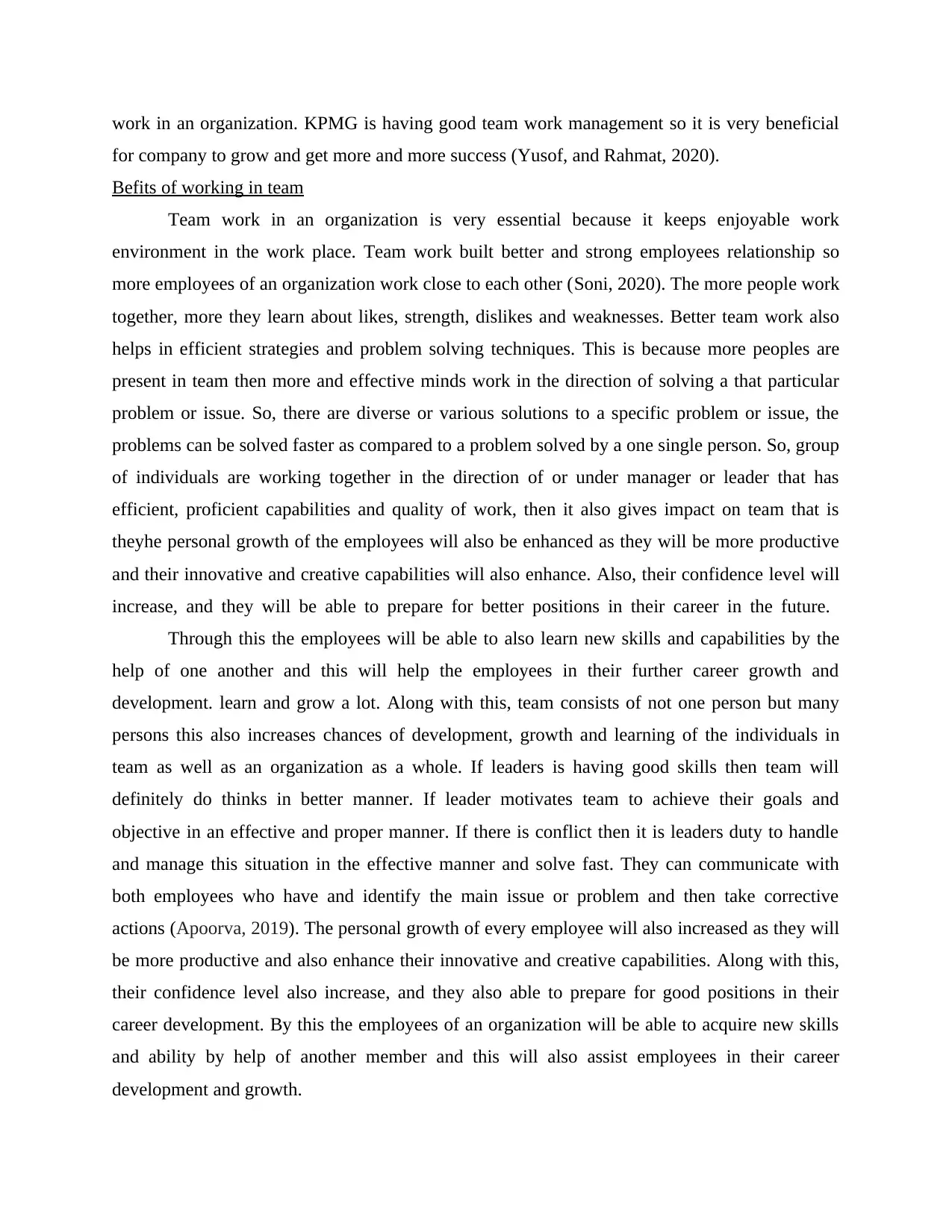
work in an organization. KPMG is having good team work management so it is very beneficial
for company to grow and get more and more success (Yusof, and Rahmat, 2020).
Befits of working in team
Team work in an organization is very essential because it keeps enjoyable work
environment in the work place. Team work built better and strong employees relationship so
more employees of an organization work close to each other (Soni, 2020). The more people work
together, more they learn about likes, strength, dislikes and weaknesses. Better team work also
helps in efficient strategies and problem solving techniques. This is because more peoples are
present in team then more and effective minds work in the direction of solving a that particular
problem or issue. So, there are diverse or various solutions to a specific problem or issue, the
problems can be solved faster as compared to a problem solved by a one single person. So, group
of individuals are working together in the direction of or under manager or leader that has
efficient, proficient capabilities and quality of work, then it also gives impact on team that is
theyhe personal growth of the employees will also be enhanced as they will be more productive
and their innovative and creative capabilities will also enhance. Also, their confidence level will
increase, and they will be able to prepare for better positions in their career in the future.
Through this the employees will be able to also learn new skills and capabilities by the
help of one another and this will help the employees in their further career growth and
development. learn and grow a lot. Along with this, team consists of not one person but many
persons this also increases chances of development, growth and learning of the individuals in
team as well as an organization as a whole. If leaders is having good skills then team will
definitely do thinks in better manner. If leader motivates team to achieve their goals and
objective in an effective and proper manner. If there is conflict then it is leaders duty to handle
and manage this situation in the effective manner and solve fast. They can communicate with
both employees who have and identify the main issue or problem and then take corrective
actions (Apoorva, 2019). The personal growth of every employee will also increased as they will
be more productive and also enhance their innovative and creative capabilities. Along with this,
their confidence level also increase, and they also able to prepare for good positions in their
career development. By this the employees of an organization will be able to acquire new skills
and ability by help of another member and this will also assist employees in their career
development and growth.
for company to grow and get more and more success (Yusof, and Rahmat, 2020).
Befits of working in team
Team work in an organization is very essential because it keeps enjoyable work
environment in the work place. Team work built better and strong employees relationship so
more employees of an organization work close to each other (Soni, 2020). The more people work
together, more they learn about likes, strength, dislikes and weaknesses. Better team work also
helps in efficient strategies and problem solving techniques. This is because more peoples are
present in team then more and effective minds work in the direction of solving a that particular
problem or issue. So, there are diverse or various solutions to a specific problem or issue, the
problems can be solved faster as compared to a problem solved by a one single person. So, group
of individuals are working together in the direction of or under manager or leader that has
efficient, proficient capabilities and quality of work, then it also gives impact on team that is
theyhe personal growth of the employees will also be enhanced as they will be more productive
and their innovative and creative capabilities will also enhance. Also, their confidence level will
increase, and they will be able to prepare for better positions in their career in the future.
Through this the employees will be able to also learn new skills and capabilities by the
help of one another and this will help the employees in their further career growth and
development. learn and grow a lot. Along with this, team consists of not one person but many
persons this also increases chances of development, growth and learning of the individuals in
team as well as an organization as a whole. If leaders is having good skills then team will
definitely do thinks in better manner. If leader motivates team to achieve their goals and
objective in an effective and proper manner. If there is conflict then it is leaders duty to handle
and manage this situation in the effective manner and solve fast. They can communicate with
both employees who have and identify the main issue or problem and then take corrective
actions (Apoorva, 2019). The personal growth of every employee will also increased as they will
be more productive and also enhance their innovative and creative capabilities. Along with this,
their confidence level also increase, and they also able to prepare for good positions in their
career development. By this the employees of an organization will be able to acquire new skills
and ability by help of another member and this will also assist employees in their career
development and growth.
⊘ This is a preview!⊘
Do you want full access?
Subscribe today to unlock all pages.

Trusted by 1+ million students worldwide
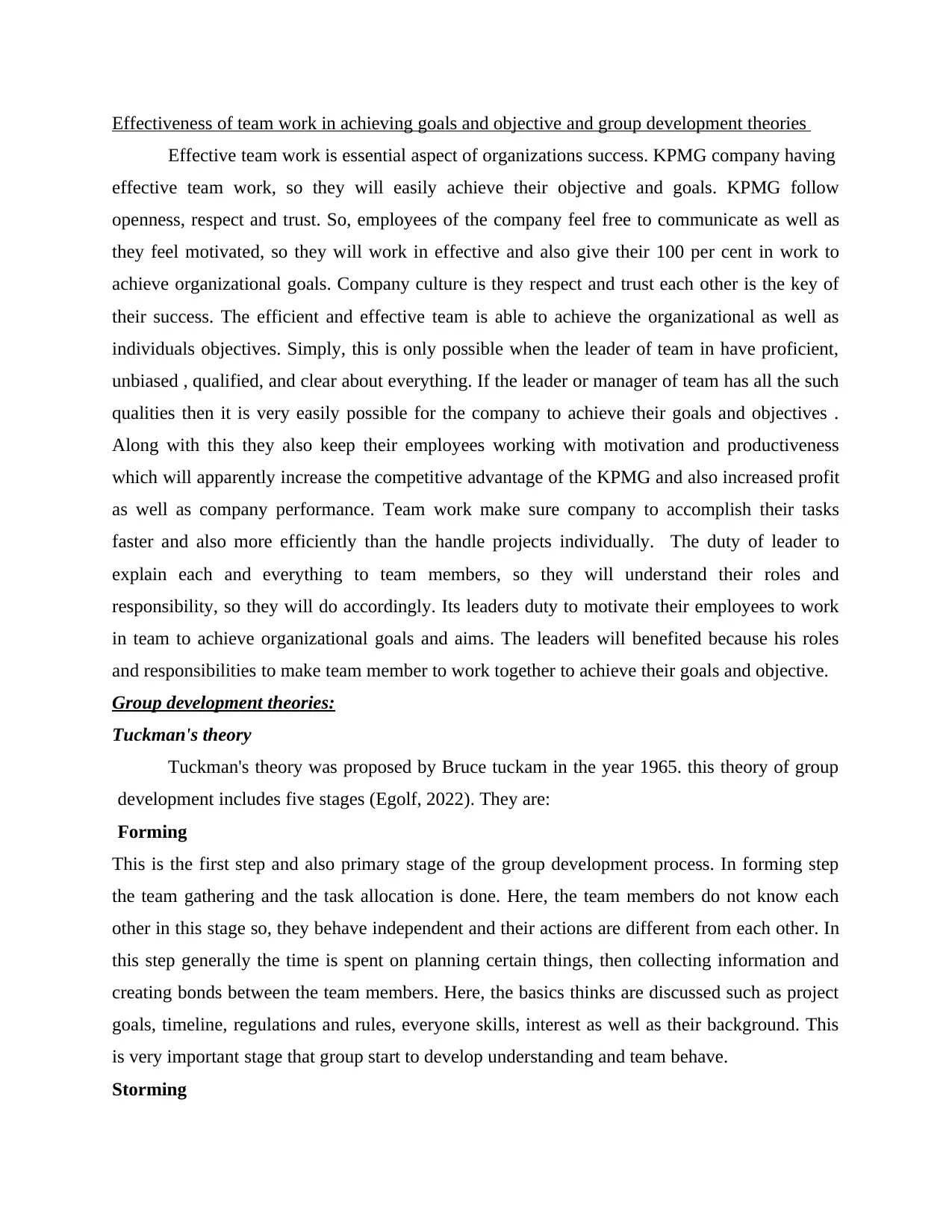
Effectiveness of team work in achieving goals and objective and group development theories
Effective team work is essential aspect of organizations success. KPMG company having
effective team work, so they will easily achieve their objective and goals. KPMG follow
openness, respect and trust. So, employees of the company feel free to communicate as well as
they feel motivated, so they will work in effective and also give their 100 per cent in work to
achieve organizational goals. Company culture is they respect and trust each other is the key of
their success. The efficient and effective team is able to achieve the organizational as well as
individuals objectives. Simply, this is only possible when the leader of team in have proficient,
unbiased , qualified, and clear about everything. If the leader or manager of team has all the such
qualities then it is very easily possible for the company to achieve their goals and objectives .
Along with this they also keep their employees working with motivation and productiveness
which will apparently increase the competitive advantage of the KPMG and also increased profit
as well as company performance. Team work make sure company to accomplish their tasks
faster and also more efficiently than the handle projects individually. The duty of leader to
explain each and everything to team members, so they will understand their roles and
responsibility, so they will do accordingly. Its leaders duty to motivate their employees to work
in team to achieve organizational goals and aims. The leaders will benefited because his roles
and responsibilities to make team member to work together to achieve their goals and objective.
Group development theories:
Tuckman's theory
Tuckman's theory was proposed by Bruce tuckam in the year 1965. this theory of group
development includes five stages (Egolf, 2022). They are:
Forming
This is the first step and also primary stage of the group development process. In forming step
the team gathering and the task allocation is done. Here, the team members do not know each
other in this stage so, they behave independent and their actions are different from each other. In
this step generally the time is spent on planning certain things, then collecting information and
creating bonds between the team members. Here, the basics thinks are discussed such as project
goals, timeline, regulations and rules, everyone skills, interest as well as their background. This
is very important stage that group start to develop understanding and team behave.
Storming
Effective team work is essential aspect of organizations success. KPMG company having
effective team work, so they will easily achieve their objective and goals. KPMG follow
openness, respect and trust. So, employees of the company feel free to communicate as well as
they feel motivated, so they will work in effective and also give their 100 per cent in work to
achieve organizational goals. Company culture is they respect and trust each other is the key of
their success. The efficient and effective team is able to achieve the organizational as well as
individuals objectives. Simply, this is only possible when the leader of team in have proficient,
unbiased , qualified, and clear about everything. If the leader or manager of team has all the such
qualities then it is very easily possible for the company to achieve their goals and objectives .
Along with this they also keep their employees working with motivation and productiveness
which will apparently increase the competitive advantage of the KPMG and also increased profit
as well as company performance. Team work make sure company to accomplish their tasks
faster and also more efficiently than the handle projects individually. The duty of leader to
explain each and everything to team members, so they will understand their roles and
responsibility, so they will do accordingly. Its leaders duty to motivate their employees to work
in team to achieve organizational goals and aims. The leaders will benefited because his roles
and responsibilities to make team member to work together to achieve their goals and objective.
Group development theories:
Tuckman's theory
Tuckman's theory was proposed by Bruce tuckam in the year 1965. this theory of group
development includes five stages (Egolf, 2022). They are:
Forming
This is the first step and also primary stage of the group development process. In forming step
the team gathering and the task allocation is done. Here, the team members do not know each
other in this stage so, they behave independent and their actions are different from each other. In
this step generally the time is spent on planning certain things, then collecting information and
creating bonds between the team members. Here, the basics thinks are discussed such as project
goals, timeline, regulations and rules, everyone skills, interest as well as their background. This
is very important stage that group start to develop understanding and team behave.
Storming
Paraphrase This Document
Need a fresh take? Get an instant paraphrase of this document with our AI Paraphraser
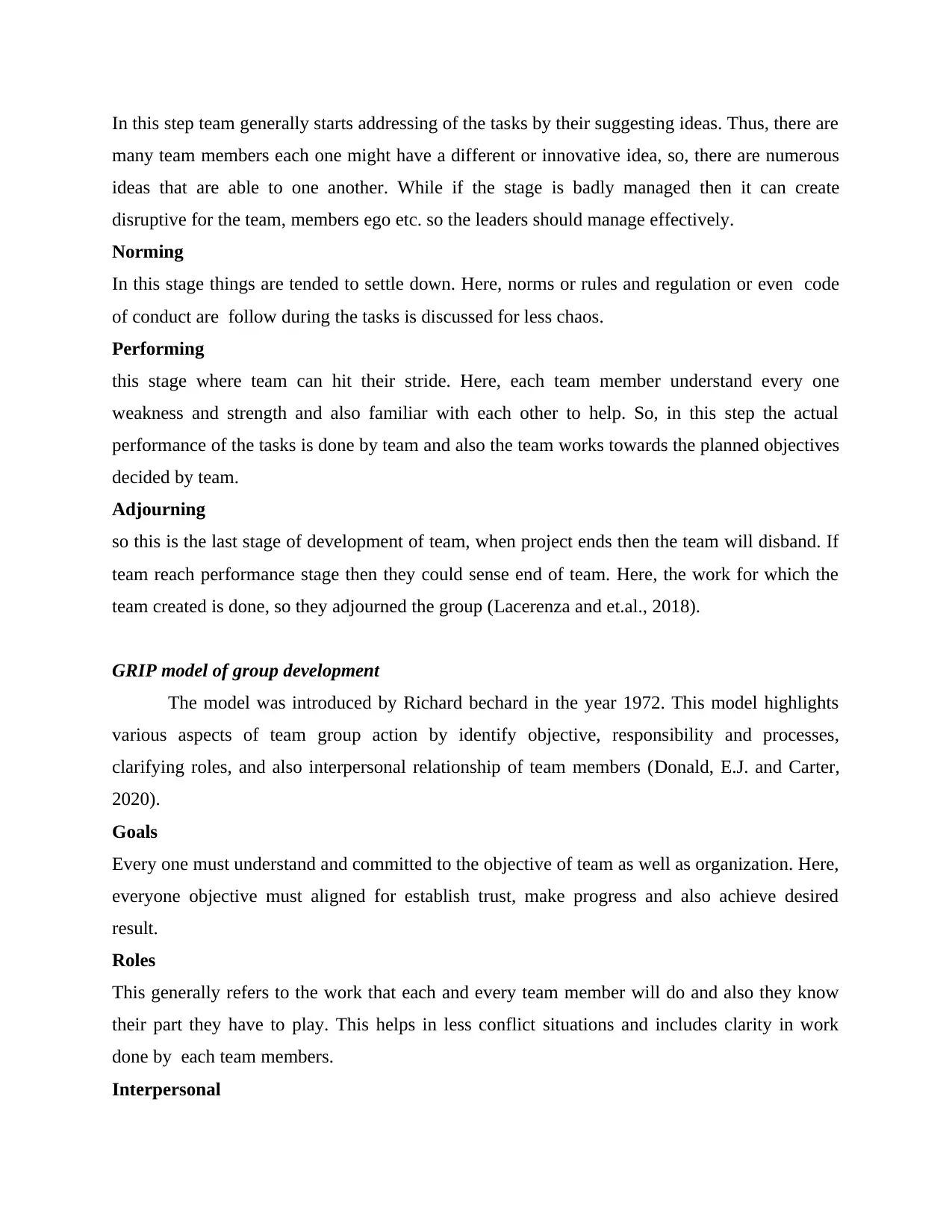
In this step team generally starts addressing of the tasks by their suggesting ideas. Thus, there are
many team members each one might have a different or innovative idea, so, there are numerous
ideas that are able to one another. While if the stage is badly managed then it can create
disruptive for the team, members ego etc. so the leaders should manage effectively.
Norming
In this stage things are tended to settle down. Here, norms or rules and regulation or even code
of conduct are follow during the tasks is discussed for less chaos.
Performing
this stage where team can hit their stride. Here, each team member understand every one
weakness and strength and also familiar with each other to help. So, in this step the actual
performance of the tasks is done by team and also the team works towards the planned objectives
decided by team.
Adjourning
so this is the last stage of development of team, when project ends then the team will disband. If
team reach performance stage then they could sense end of team. Here, the work for which the
team created is done, so they adjourned the group (Lacerenza and et.al., 2018).
GRIP model of group development
The model was introduced by Richard bechard in the year 1972. This model highlights
various aspects of team group action by identify objective, responsibility and processes,
clarifying roles, and also interpersonal relationship of team members (Donald, E.J. and Carter,
2020).
Goals
Every one must understand and committed to the objective of team as well as organization. Here,
everyone objective must aligned for establish trust, make progress and also achieve desired
result.
Roles
This generally refers to the work that each and every team member will do and also they know
their part they have to play. This helps in less conflict situations and includes clarity in work
done by each team members.
Interpersonal
many team members each one might have a different or innovative idea, so, there are numerous
ideas that are able to one another. While if the stage is badly managed then it can create
disruptive for the team, members ego etc. so the leaders should manage effectively.
Norming
In this stage things are tended to settle down. Here, norms or rules and regulation or even code
of conduct are follow during the tasks is discussed for less chaos.
Performing
this stage where team can hit their stride. Here, each team member understand every one
weakness and strength and also familiar with each other to help. So, in this step the actual
performance of the tasks is done by team and also the team works towards the planned objectives
decided by team.
Adjourning
so this is the last stage of development of team, when project ends then the team will disband. If
team reach performance stage then they could sense end of team. Here, the work for which the
team created is done, so they adjourned the group (Lacerenza and et.al., 2018).
GRIP model of group development
The model was introduced by Richard bechard in the year 1972. This model highlights
various aspects of team group action by identify objective, responsibility and processes,
clarifying roles, and also interpersonal relationship of team members (Donald, E.J. and Carter,
2020).
Goals
Every one must understand and committed to the objective of team as well as organization. Here,
everyone objective must aligned for establish trust, make progress and also achieve desired
result.
Roles
This generally refers to the work that each and every team member will do and also they know
their part they have to play. This helps in less conflict situations and includes clarity in work
done by each team members.
Interpersonal
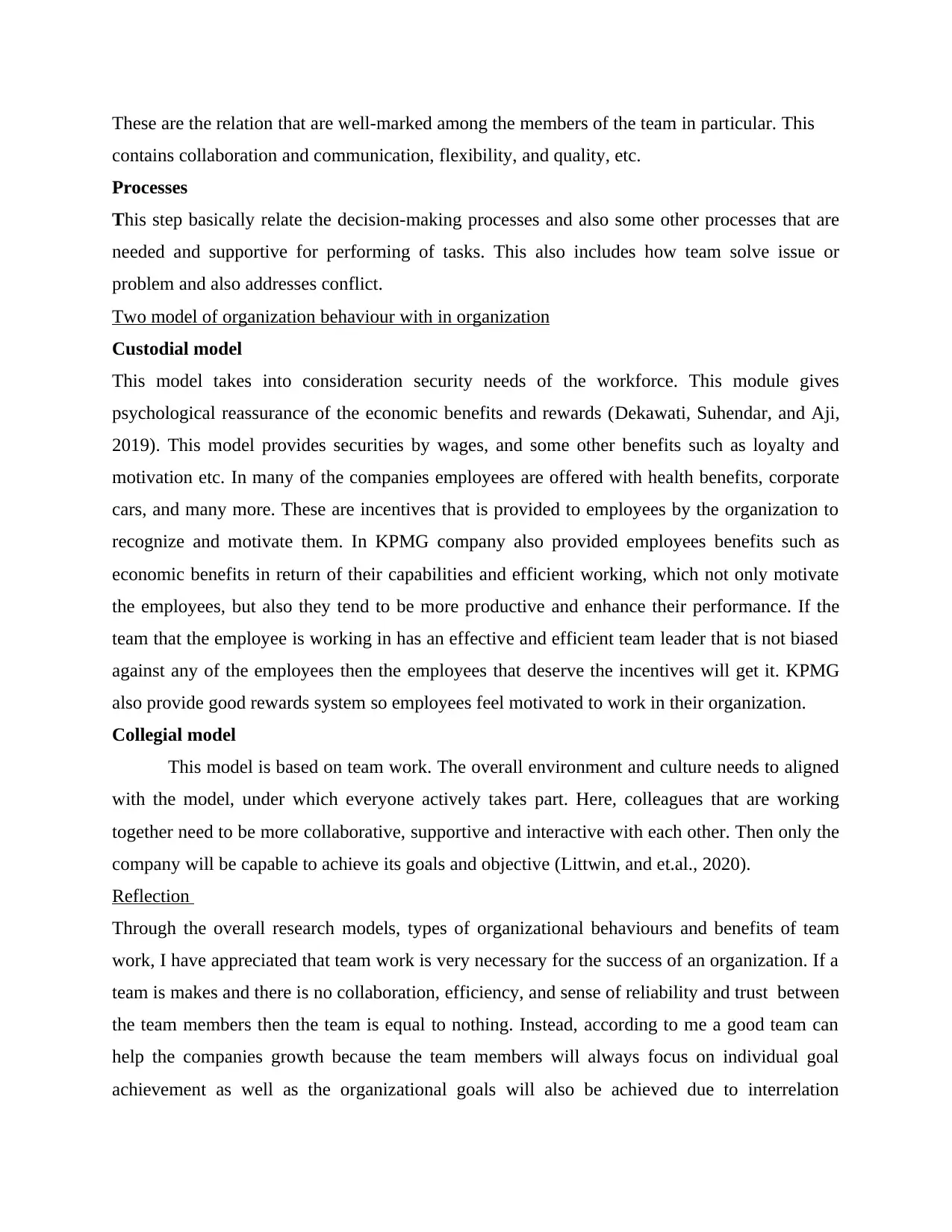
These are the relation that are well-marked among the members of the team in particular. This
contains collaboration and communication, flexibility, and quality, etc.
Processes
This step basically relate the decision-making processes and also some other processes that are
needed and supportive for performing of tasks. This also includes how team solve issue or
problem and also addresses conflict.
Two model of organization behaviour with in organization
Custodial model
This model takes into consideration security needs of the workforce. This module gives
psychological reassurance of the economic benefits and rewards (Dekawati, Suhendar, and Aji,
2019). This model provides securities by wages, and some other benefits such as loyalty and
motivation etc. In many of the companies employees are offered with health benefits, corporate
cars, and many more. These are incentives that is provided to employees by the organization to
recognize and motivate them. In KPMG company also provided employees benefits such as
economic benefits in return of their capabilities and efficient working, which not only motivate
the employees, but also they tend to be more productive and enhance their performance. If the
team that the employee is working in has an effective and efficient team leader that is not biased
against any of the employees then the employees that deserve the incentives will get it. KPMG
also provide good rewards system so employees feel motivated to work in their organization.
Collegial model
This model is based on team work. The overall environment and culture needs to aligned
with the model, under which everyone actively takes part. Here, colleagues that are working
together need to be more collaborative, supportive and interactive with each other. Then only the
company will be capable to achieve its goals and objective (Littwin, and et.al., 2020).
Reflection
Through the overall research models, types of organizational behaviours and benefits of team
work, I have appreciated that team work is very necessary for the success of an organization. If a
team is makes and there is no collaboration, efficiency, and sense of reliability and trust between
the team members then the team is equal to nothing. Instead, according to me a good team can
help the companies growth because the team members will always focus on individual goal
achievement as well as the organizational goals will also be achieved due to interrelation
contains collaboration and communication, flexibility, and quality, etc.
Processes
This step basically relate the decision-making processes and also some other processes that are
needed and supportive for performing of tasks. This also includes how team solve issue or
problem and also addresses conflict.
Two model of organization behaviour with in organization
Custodial model
This model takes into consideration security needs of the workforce. This module gives
psychological reassurance of the economic benefits and rewards (Dekawati, Suhendar, and Aji,
2019). This model provides securities by wages, and some other benefits such as loyalty and
motivation etc. In many of the companies employees are offered with health benefits, corporate
cars, and many more. These are incentives that is provided to employees by the organization to
recognize and motivate them. In KPMG company also provided employees benefits such as
economic benefits in return of their capabilities and efficient working, which not only motivate
the employees, but also they tend to be more productive and enhance their performance. If the
team that the employee is working in has an effective and efficient team leader that is not biased
against any of the employees then the employees that deserve the incentives will get it. KPMG
also provide good rewards system so employees feel motivated to work in their organization.
Collegial model
This model is based on team work. The overall environment and culture needs to aligned
with the model, under which everyone actively takes part. Here, colleagues that are working
together need to be more collaborative, supportive and interactive with each other. Then only the
company will be capable to achieve its goals and objective (Littwin, and et.al., 2020).
Reflection
Through the overall research models, types of organizational behaviours and benefits of team
work, I have appreciated that team work is very necessary for the success of an organization. If a
team is makes and there is no collaboration, efficiency, and sense of reliability and trust between
the team members then the team is equal to nothing. Instead, according to me a good team can
help the companies growth because the team members will always focus on individual goal
achievement as well as the organizational goals will also be achieved due to interrelation
⊘ This is a preview!⊘
Do you want full access?
Subscribe today to unlock all pages.

Trusted by 1+ million students worldwide
1 out of 15
Related Documents
Your All-in-One AI-Powered Toolkit for Academic Success.
+13062052269
info@desklib.com
Available 24*7 on WhatsApp / Email
![[object Object]](/_next/static/media/star-bottom.7253800d.svg)
Unlock your academic potential
Copyright © 2020–2025 A2Z Services. All Rights Reserved. Developed and managed by ZUCOL.





